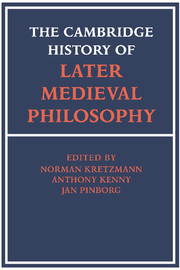 The Cambridge History of Later Medieval Philosophy
The Cambridge History of Later Medieval Philosophy from VII - Natural philosophy
Published online by Cambridge University Press: 28 March 2008
The identity and the writings of the Calculators or ‘Mertonians’
In the second quarter of the fourteenth century a collection of works was produced at Oxford whose joint impact on European natural philosophy lasted well into the sixteenth century. The works at the core of this collection are Thomas Bradwardine's De proportionibus velocitatum (1328), William Heytesbury's Regulae solvendi sophismata (1335), and Richard Swineshead's Liber calculationum (usually dated ca. 1350, but probably earlier). Other treatises were linked with these three through common interests and approaches in logic, in mathematics, and in physics or natural philosophy. Among the most closely linked works were Richard Kilvington's Sophismata, Walter Burley's De primo et ultimo instanti and Tractatus primus et secundus de formis accidentalibus (the Tractatus secundus is known better as De intensione et remissione formarum), Richard Billingham's Conclusiones, Heytesbury's Sophismata and the Probationes Conclusionum of his Regulae, Roger Swineshead's De motibus naturalibus, John Bode's treatise on the sophisma ‘A est unum calidum’ and others, the anonymous Sex inconvenientia, and John Dumbleton's Summa logicae et philosophiae naturalis, not to mention many treatises on the usual subjects of fourteenth-century logic – supposition, consequences, obligationes, insolubilia, etc. – or commentaries on Aristotle's physical works and other set books of the medieval curriculum.
Since many of the most famous authors of these works, including Bradwardine, Heytesbury, Richard Swineshead, Burley, Dumbleton, and possibly also Bode, had been fellows of Merton College, Oxford, some recent historians of science call this group of authors the Merton School, although there is little contemporary evidence that they were called Mertonians.
To save this book to your Kindle, first ensure no-reply@cambridge.org is added to your Approved Personal Document E-mail List under your Personal Document Settings on the Manage Your Content and Devices page of your Amazon account. Then enter the ‘name’ part of your Kindle email address below. Find out more about saving to your Kindle.
Note you can select to save to either the @free.kindle.com or @kindle.com variations. ‘@free.kindle.com’ emails are free but can only be saved to your device when it is connected to wi-fi. ‘@kindle.com’ emails can be delivered even when you are not connected to wi-fi, but note that service fees apply.
Find out more about the Kindle Personal Document Service.
To save content items to your account, please confirm that you agree to abide by our usage policies. If this is the first time you use this feature, you will be asked to authorise Cambridge Core to connect with your account. Find out more about saving content to Dropbox.
To save content items to your account, please confirm that you agree to abide by our usage policies. If this is the first time you use this feature, you will be asked to authorise Cambridge Core to connect with your account. Find out more about saving content to Google Drive.